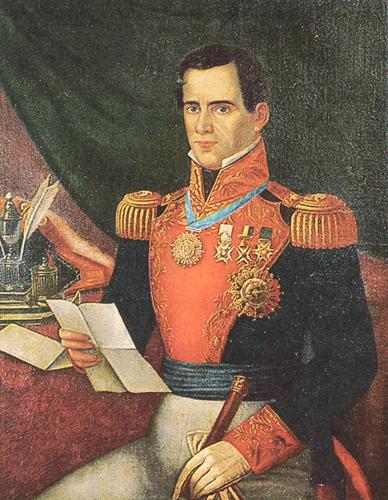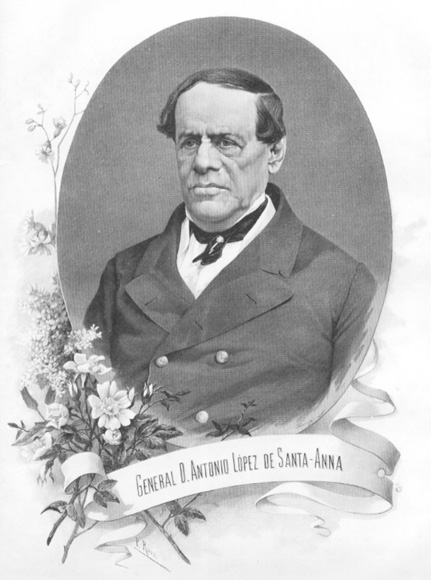Santa Ana
Antonio López was born to lower-middle class parents in Xalapa. His father (from Spain), was a minor official in the Spanish colonial bureaucracy; his mother came from France. In 1810 he joined the Spanish military where he rose to the rank of second lieutenant by 1812. He saw action in the service of Spain in attempts to put down Mexican independence revolt.
In 1821 he switched sides and declared his loyalty to rebel leader Agustín de Iturbide. He rose to prominence by driving the Spanish forces out of the port city of Veracruz in 1821. Iturbide rewarded him with the rank of General and appointed him Governor of Veracruz. While serving in the military under José Arredondo, Santa Anna learned how to brutely deal with ones enemies. In 1823, however, Santa Anna was among the military leaders supporting the Plan de Casa Mata to overthrow Iturbide and declare Mexico a Republic. In 1823 he turned on Iturbide. Santa Anna played important roles in replacing presidents Manuel Gómez Pedraza and Vicente Guerrero.

In 1829 Spain made its final attempt to retake Mexico, landing a force of 2,600 soldiers at Tampico. Santa Anna marched against them with a smaller force and defeated the Spaniards, many of whom were suffering from yellow fever. Santa Anna was declared a hero, which he much relished, and from then on he styled himself "The Victor of Tampico" and "The Savior of the Fatherland". Santa Anna declared himself retired, "unless my country needs me". He decided he was needed when Anastasio Bustamante led a coup overthrowing and killing President Vicente Guerrero. Santa Anna seized power in the confusion and then was elected President in 1833. At first he had little interest in actually running the country, giving a free hand to his vice-president Valentín Gómez Farías, a liberal reformer.
Gómez Farías worked hard to root out corruption, which stepped on some powerful toes among the military and wealthy landowners and Catholic church. When these voiced their displeasure, Santa Anna dismissed Gómez Farías, declared the Constitution suspended, disbanded the Congress, and worked to concentrate power in the central government. This was applauded by some conservatives but met with considerable disapproval from other sectors. Several states went into open rebellion; San Luis Potosí, Querétaro, Durango, Guanajuato, Michoacán, Yucatán, Jalisco and Zacatecas. The Zacatecan militia, armed with.753 British 'Brown Bess' muskets, Baker .61 rifles, lead by Francisco Garcia, was the largest of all the Mexican states. After two hours of combat, on 12 May 1835, the "Army of Operations" defeated the Zacatecan militia and took almost 3,000 prisoners. He let his army ransack the city for forty-eight hours. Santa Anna planned on putting down the rebellion first in Zacatecas then move to Coahuila y Tejas.
The Texas part of the Mexican state of Coahuila y Tejas went into rebellion in late 1835 and declared itself independent on 2 March 1836 (see Texas Revolution and Republic of Texas); Santa Anna marched north to bring the rebellious province back under his control. His forces defeated the small Texas force at the Battle of the Alamo, but Santa Anna was himself in turn defeated at the Battle of San Jacinto. Santa Anna was captured by Texas forces the day after the battle on 22 April 1836 and was forced to allow Texan independence on the condition that Texas would remain independent and not accede to the USA. Back in Mexico City, a new government declared that Santa Anna was no longer president and the treaty thus null and void. After some time in exile in the United States, in 1837 he was allowed to return to Mexico to retire at his hacienda.
In 1838 Santa Anna saw a chance to redeem himself when French forces invaded Mexico in the Pastry War. He engaged the French at Veracruz and, in the skirmishing, was hit by a cannon ball. As a result of his injuries, his leg was amputated. He ordered the limb buried with full military honors, and from then on at public events he would ride on horseback holding his wooden leg over his head as a symbol of his sacrifices for his country. Santa Anna held on to control of his troops after the French had left, at first in support of Bustamante, then declaring himself once again President.
Santa Anna's second rule was even more dictatorial than the first. His demands for ever greater taxes aroused ire, and several Mexican states simply stopped dealing with the central government, Yucatán and Laredo going so far as to declare themselves independent republics. In December 1844, opposition had reached the point where Santa Anna decided it was wise to accept an offer (in the interests of avoiding a civil war) to renounce all claims to the Presidency and go into exile in exchange for a generous pension. Santa Anna then moved to Cuba.
In 1846 the United States declared war on Mexico. Santa Anna wrote to Mexico City saying he no longer had aspirations to the presidency but would eagerly use his military experience to fight off the foreign invasion of Mexico as he had in the past. President Gómez Farías was desperate enough to accept the offer and allowed Santa Anna to return. Meanwhile, Santa Anna had secretly been dealing with representatives of the USA, pledging that if he were allowed back in Mexico through the blockades, he would work to sell all contested territory to the United States at a reasonable price. Once back in Mexico at the head of an army, Santa Anna reneged on both of these agreements. Santa Anna declared himself president again and unsuccessfully tried to fight off the United States invasion.

In 1851 Santa Anna went into exile in Kingston, Jamaica, and two years after moved to Turbaco, Colombia. In 1853 he was invited back by rebellious conservatives, with whom he succeeded in retaking the government. This reign was no better than his earlier ones. He funneled government funds to his own pockets, sold more territory to the United States, and declared himself dictator for life with the title "Most Serene Highness".
Despite his generous pay-offs to the military for loyalty, by 1855 even his conservative allies had had enough of Santa Anna. That year a group of liberals led by Benito Juárez and Ignacio Comonfort overthrew Santa Anna, and he fled back to Cuba. As the extent of his corruption became known he was tried in absentia for treason and all his estates confiscated. He then lived in exile in Cuba, the United States, Colombia, and St. Thomas. During his time in New York City he is credited as bringing the first shipments of chicle, the base of chewing gum, to the United States, but he failed to profit from this since his plan was to use the chicle to replace rubber in carriage tires, which was tried without success. The American assigned to aid Santa Anna while he was in the US, James Adams, conducted experiments with the chicle and called it "Chiclets" which helped found the chewing gum industry. Santa Anna was a passionate fan of the sport of cockfighting. He would invite breeders from all over the world for matches and is known to have spent tens of thousands of dollars on prize roosters. In 1874 he took advantage of a general amnesty and returned to Mexico.
Santa Anna died two years later, on 21 June 1876, in poverty and obscurity in Mexico City. His last years were lonely and unhappy. Crippled and almost blind by cataracts he was ignored by the Mexican government when the anniversary of the Battle of Churubusco occurred.
All text is available under the terms of the GNU Free Documentation License.